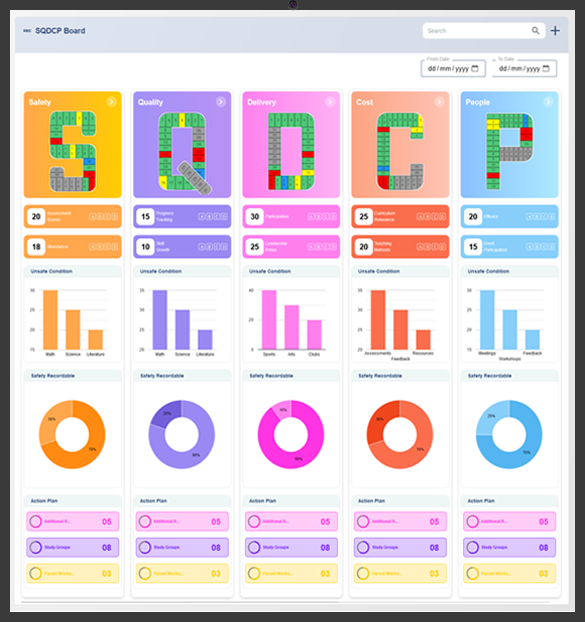Effective strategy planning and management require a structured approach to align business activities with long-term goals. The Balanced Scorecard (BSC) serves as a comprehensive framework that helps organizations translate their vision into actionable objectives, measure performance, and drive continuous improvement.

1. Understanding the Balanced Scorecard
The Balanced Scorecard is a strategic management tool that provides a structured way to track key performance indicators (KPIs) across four critical perspectives:
- Financial Perspective: Measures financial stability, revenue growth, and profitability.
- Customer Perspective: Focuses on customer satisfaction, retention, and value delivery.
- Internal Process Perspective: Tracks efficiency, process optimization, and operational effectiveness.
- Learning and Growth Perspective: Evaluates employee development, skill enhancement, and innovation.
2. Key Features of the Balanced Scorecard
- Goal Alignment: Ensures all activities contribute to strategic objectives.
- Performance Measurement: Provides measurable outcomes to track progress.
- Data-Driven Insights: Enables informed decision-making based on performance data.
- Strategy Communication: Clearly conveys business objectives to stakeholders.
- Continuous Improvement: Identifies areas for optimization and refinement.
3. How to Implement a Balanced Scorecard
Step 1: Define Strategic Objectives
Identify key business goals aligned with the four Balanced Scorecard perspectives. Ensure each objective is clear, measurable, and supports the company’s long-term vision.
Step 2: Select Key Performance Indicators (KPIs)
Establish relevant KPIs to track progress. Examples include revenue growth rates, customer satisfaction scores, operational efficiency ratios, and employee training metrics.
Step 3: Develop a Strategic Map
Create a visual representation linking strategic objectives to business activities. This helps identify relationships between different perspectives and ensures comprehensive goal tracking.
Step 4: Implement Performance Tracking
Utilize a tracking system to monitor KPI performance regularly. Adjust strategies and initiatives based on real-time data insights.
Step 5: Review and Optimize
Regularly assess Balanced Scorecard performance, identify areas for improvement, and refine strategies to enhance effectiveness.
4. Benefits of Using a Balanced Scorecard
- Improved Strategic Focus: Aligns daily operations with long-term objectives.
- Better Decision-Making: Provides actionable insights based on performance data.
- Enhanced Accountability: Clearly defines roles and responsibilities.
- Holistic Performance Measurement: Evaluates multiple aspects of business success.
- Operational Efficiency: Streamlines processes to eliminate inefficiencies.
- Long-Term Growth: Supports sustainable business development.
5. Future of Balanced Scorecard
As businesses continue evolving, the Balanced Scorecard will integrate with digital technologies, offering automation, AI-driven insights, and enhanced data visualization. Future advancements may include predictive analytics, automated performance recommendations, and seamless integration with other business management tools. By adopting a Balanced Scorecard approach, organizations can create a clear roadmap for success, improve strategy execution, and drive long-term value creation.
Implementing a Balanced Scorecard framework is a key step toward achieving strategic goals, improving management practices, and ensuring sustainable growth. By continuously refining the approach, organizations can stay competitive and effectively navigate market challenges.
Balanced Scorecard for Strategy Planning and Management
What is a Balanced Scorecard in strategy planning?
A Balanced Scorecard is a strategic management tool that helps organizations align their activities with long-term goals by tracking performance across key areas.
How does a Balanced Scorecard support management decision-making?
It provides a structured approach to measuring performance, helping managers make informed decisions based on financial, operational, and strategic data.
Can a Balanced Scorecard be customized for different organizations?
Yes, it can be customized by defining key performance indicators (KPIs) that align with specific business goals and industry requirements.
What are the four key perspectives of a Balanced Scorecard?
The four key perspectives are financial performance, customer satisfaction, internal processes, and learning and growth.
How do you implement a Balanced Scorecard for strategy planning?
Implementation involves defining objectives, selecting performance metrics, setting targets, and regularly reviewing progress.
What types of metrics should be included in a Balanced Scorecard?
Metrics should cover financial results, operational efficiency, customer engagement, employee performance, and innovation.
How does a Balanced Scorecard improve performance measurement?
It provides a holistic view of organizational performance by combining financial and non-financial indicators to track progress.
Can a Balanced Scorecard be used for long-term strategic planning?
Yes, it helps organizations set long-term objectives and measure progress towards strategic goals over time.
How do you align a Balanced Scorecard with business objectives?
It aligns with business objectives by linking key performance indicators to specific strategic goals and tracking their progress.
What are the benefits of using a Balanced Scorecard for management?
Benefits include improved strategic alignment, better decision-making, enhanced communication, and a clear focus on key performance areas.
How does a Balanced Scorecard enhance communication within an organization?
It ensures transparency by providing a clear framework for tracking goals, sharing performance updates, and aligning teams.
Can a Balanced Scorecard be integrated with performance reviews?
Yes, it can be used as part of employee evaluations by linking individual performance to overall business objectives.
How do you track progress using a Balanced Scorecard?
Progress is tracked by regularly updating key performance indicators and reviewing performance against strategic goals.
What are the best practices for using a Balanced Scorecard effectively?
Best practices include setting clear objectives, regularly reviewing performance, and ensuring alignment across all levels of the organization.
Is a Balanced Scorecard suitable for both small and large organizations?
Yes, it is scalable and can be tailored to meet the needs of small businesses as well as large enterprises.